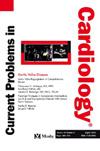Noninvasive assessment of myocardial stiffness using shear wave elastography in Amyloidosis and Fabry disease
IF 3.3
3区 医学
Q2 CARDIAC & CARDIOVASCULAR SYSTEMS
引用次数: 0
Abstract
Background/Objectives
Diastolic function comprises MS and impaired relaxation, and is essential for the comprehensive analysis of heart failure. The goal of this study was to investigate the use of cardiac shear wave elastography for assessing shear wave propagation speed and myocardial stiffness (MS) in Fabry disease (FD), cardiac amyloidosis (CA) and healthy volunteers (HV).
Methods
We prospectively enrolled 60 participants, with 20 patients each in the CA, FD and HV groups. Echocardiogram, blood exams and walking test were achieved. MS evaluation was performed using an ultrasound scanner. Results: Shear wave propagation speed and MS were significantly higher in patients with CA than in HV in the basal anteroseptal segment (MS PLAX 6.6 ± 1.4 kPa vs. 5.38 ± 1.1 kPa, respectively, p = 0.01; PSAX 6.86 ± 1.4 kPa vs. 5.6 ± 1.2 kPa, respectively, p = 0.01) and in the right ventricle (5.9 ± 2.6 kPa vs. 4.0 ± 0.7 kPa, respectively, p = 0.003), with no difference in the mid anteroseptal segment and the apical septal. There was a difference in the MS of patients with CA in the right ventricle when compared to the FD group (5.9 ± 2.6 kPa vs. 4.4 ± 1.0 kPa, respectively, p = 0.01). There was no statistical difference between any myocardial segment in the FD group compared to the HV group. Conclusions: Shear wave propagation speed and MS were higher in patients with CA compared to FD and healthy volunteers. Evaluation of FD group did not reveal any difference from the control group
用剪切波弹性成像无创评估淀粉样变性和法布里病的心肌硬度
背景/目的舒张功能包括MS和舒张功能受损,对心衰的综合分析至关重要。本研究的目的是探讨心脏剪切波弹性成像在法布里病(FD)、心脏淀粉样变性(CA)和健康志愿者(HV)中评估剪切波传播速度和心肌刚度(MS)的应用。方法前瞻性入组60例,CA组、FD组和HV组各20例。完成超声心动图、血液检查和步行检查。使用超声扫描仪进行质谱评估。结果:CA患者基底房间隔段横波传播速度和MS均显著高于HV患者(MS PLAX分别为6.6±1.4 kPa和5.38±1.1 kPa, p = 0.01;PSAX分别为6.86±1.4 kPa vs. 5.6±1.2 kPa, p = 0.01),右心室分别为5.9±2.6 kPa vs. 4.0±0.7 kPa, p = 0.003),室间隔中段和顶间隔无差异。与FD组相比,CA组右心室MS有差异(5.9±2.6 kPa vs 4.4±1.0 kPa, p = 0.01)。与HV组相比,FD组各心肌节段间无统计学差异。结论:与FD和健康志愿者相比,CA患者的横波传播速度和MS更高。FD组的评估结果与对照组无明显差异
本文章由计算机程序翻译,如有差异,请以英文原文为准。
求助全文
约1分钟内获得全文
求助全文
来源期刊

Current Problems in Cardiology
医学-心血管系统
CiteScore
4.80
自引率
2.40%
发文量
392
审稿时长
6 days
期刊介绍:
Under the editorial leadership of noted cardiologist Dr. Hector O. Ventura, Current Problems in Cardiology provides focused, comprehensive coverage of important clinical topics in cardiology. Each monthly issues, addresses a selected clinical problem or condition, including pathophysiology, invasive and noninvasive diagnosis, drug therapy, surgical management, and rehabilitation; or explores the clinical applications of a diagnostic modality or a particular category of drugs. Critical commentary from the distinguished editorial board accompanies each monograph, providing readers with additional insights. An extensive bibliography in each issue saves hours of library research.
 求助内容:
求助内容: 应助结果提醒方式:
应助结果提醒方式:


